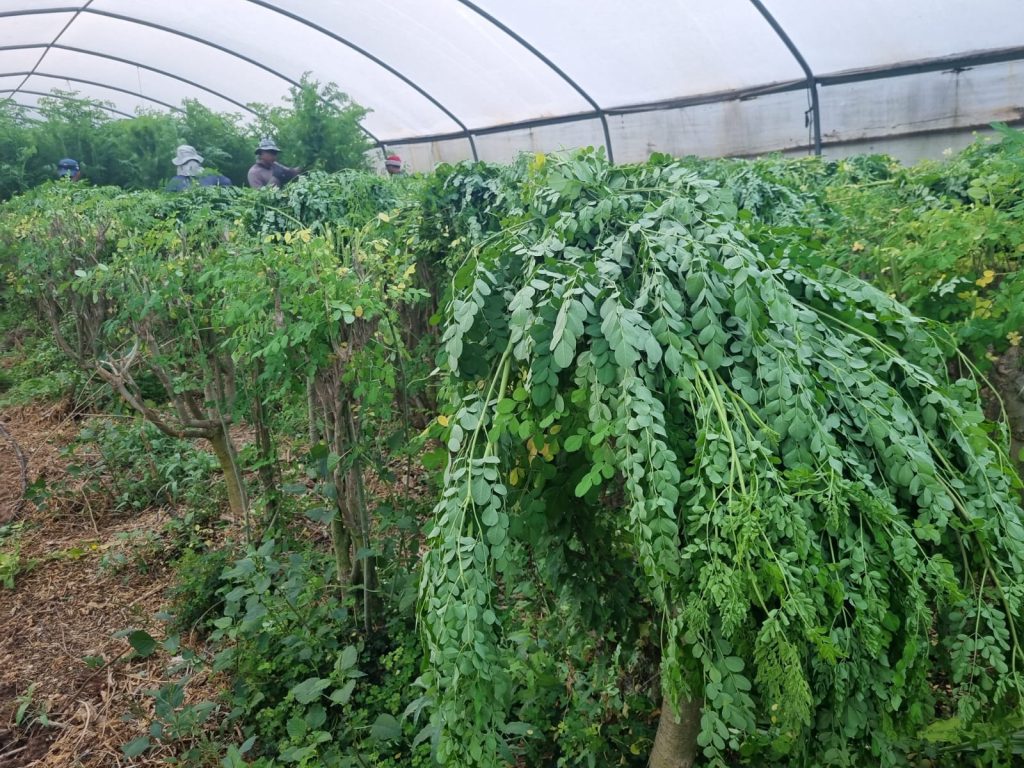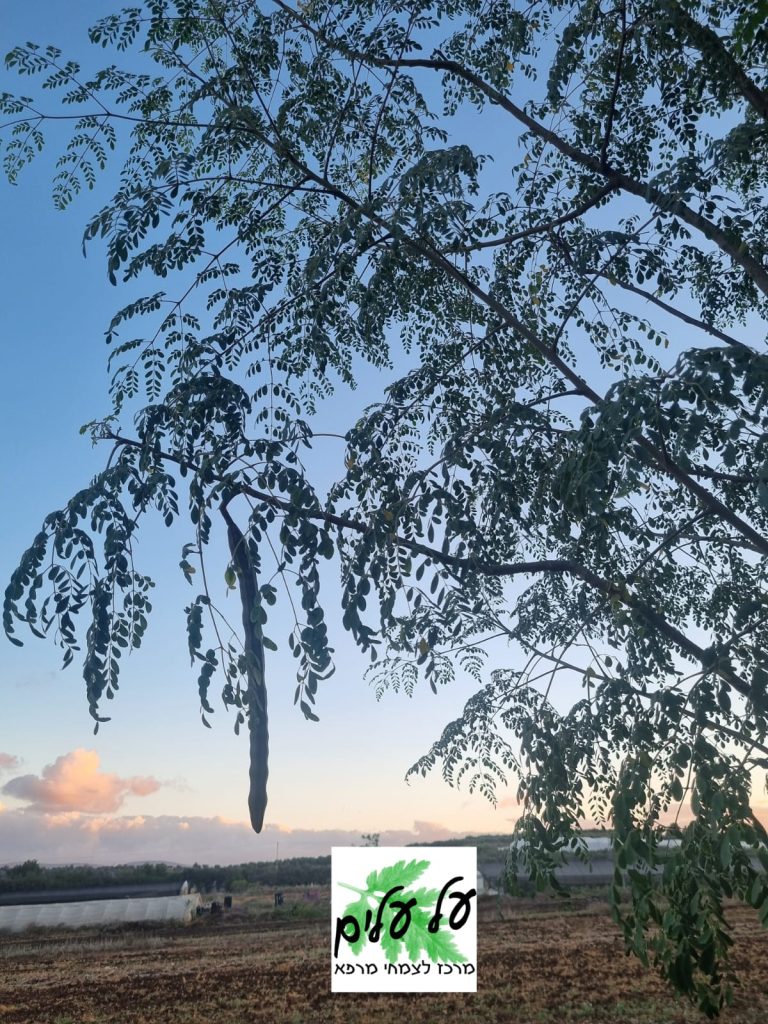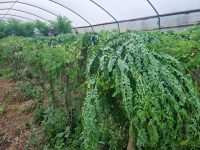Moringa oleifera, Moringaceae
Hebrew name: Winged Moringa – (מורינגה מכונפת)
In memory of the late Maya Ben-David,
a loyal advocate of the Moringa tree, and a friend to everyone.
The winged moringa (Moringa oleifera), relatively a new crop in Israel, has received extensive media coverage in Israel in recent years. The plant has gained great popularity, and thousands of Israelis have already experimented with consuming the leaves.
The late Dr. David Meikin brought the winged moringa to Israel as an agricultural crop in 2004, and founded "The Moringa Distribution Company" in Moshav Kfar Haim in 2008. Meikin's vision was of moringa being a high-quality source of nutrition in Israel, and for other diverse uses. He collected various species of moringa from around the world, invested his wealth and energy in research, in developing new cultivation methods and processing of the produce for various purposes, among them also feed for livestock. Since then, moringa trees have become a common sight in gardens Israel. The agricultural cultivation of moringa has also expanded, mainly in the valleys and in the south of the country, but also in the lowlands and even in the southern Golan Heights. The moringa tree is a source of food, nutritional supplements and cosmetics). The leaves and seeds are the plant parts which are approved as human nutritional supplements in Israel. The oil extracted from the seeds is not approved for use in Israel yet, but approved for external use.
The tree, which originates from the slopes of the Himalayas, does not require much effort in its growing. It can survive in arid zones, but it also responds well to irrigation and mineral nutrition. Moringa cultivation is proposed for famine-stricken or drought-stricken areas in Africa, thanks to its resistance to drought on one hand, and a phenomenal growth rate under optimal growing conditions, on the other hand. In its first year, the tree is sensitive to cold, and its upper parts will be damaged in temperatures below freezing, but the plant will usually regenerate from the ground in the spring, without any significant damage.
All parts of the tree have medicinal value. In East Asian folk medicine, the leaves and seed pods are considered a rich source of protein, vitamins and minerals. In India, moringa trees ("Drumstick") are planted in the backyards of houses in many parts of the country.
As food, the unique nutritional composition of moringa leaves makes them a health food or "superfood". Worthy of special mention is the high protein concentration – 7-10% of fresh weight, and up to 40% for dry weight – in orchards of intensive cultivation in Israel (personal information). One hundred grams of fresh moringa leaves may provide a protein dose equal to one-sixth (17%) of the daily protein requirement for an adult, and contains at least 10 essential amino acids. The leaves also contain a relatively high proportion (57%) of unsaturated fatty acids. Of these, alpha-linoleic acid is in the highest concentration.
On the internet, one can find inaccurate and exaggerated data regarding the concentrations of minerals and vitamins in moringa leaves. However, the concentrations of vitamins E, A and C, and concentrations of minerals in the leaves (iron, calcium, magnesium, zinc) are relatively high, and important for their nutritional value.
The leaves can be eaten fresh (salads) or cooked (infusions, soup and stews). The leaves have a mustard-like taste. The tree is endowed with fragrant white flowers, and long pods (up to 40 cm) bearing seeds 4-8 mm in diameter. The seeds are crowned with wing-like arches, which gave the tree its Hebrew name. The young fruit pods are eaten, and also the fresh seeds, cooked or in their natural state. The seeds have a special and characteristic spicy taste, which quickly changes to a sweetness reminiscent of nuts or peanuts. The oil has a delicate taste, similar to olive oil in its composition. It is clear, almost odorless, and has uses in food (not yet approved in Israel) and cosmetics. The root is spicy and tastes like horseradish, hence the English name of the tree (Horseradish tree).
In Israel, moringa leaves, flowers and fruit pods are usually consumed. The studies indicate a high content of iron, calcium, zinc and magnesium in the leaves. One of the main enzymes required for the production of vitamin C is found in significant expression in the tree.

The medicinal action of moringa leaves has been studied and proven in several areas:
An anti-diabetic, anti-inflammatory, antioxidant, blood pressure-lowering and milk-increasing effect was found in lactating women. Morinaga has a relatively high content of substances called glucosinolates (they are responsible for moringa's "mustard-like" taste), and a wide variety of natural substances such as crypto-chlorogenic acid, isoquercetin, astragalin, tannins and saponins. Most of them are antioxidants which are responsible for reducing inflammation and blood pressure, and eliminating free radicals. In traditional medicine in India, the leaves are used to treat intestinal parasites and the fresh leaves, squeezed into juice, are accepted for lowering sugar and blood pressure, and for increasing breast milk. The antidiabetic effect of the whole leaves (or powder) has been demonstrated in several human trials. A large number of experiments in animals and humans have proven the tissue-preserving, antioxidant, immune-modulatory effects, blood pressure-lowering, anti-arteriosclerosis, anti-depressant, liver protector, thyroid level regulator, and more.
Moringa leaf infusion may cure stomach ulcers and diarrhea. Leaves are also used to treat fever, bronchitis, eye and ear infections. The iron content of the leaves is high, and they are also accepted in the treatment of anemia. Wide folk use also exists for arthritis, asthma and digestive problems. To obtain the full nutritional and medicinal benefits, consuming the whole or ground leaves is preferable to infusing the leaves, or using an extract.
Studies have shown an anticancer effect and cytotoxicity, antiproliferative, induction of apoptosis on human cancer cells, and radiation protection. A number of studies carried out in laboratory animals have demonstrated a distinct effect in lowering the concentration of cholesterol and fats in the blood. Another study justified the traditional use of M. oleifera leaf extract for the treatment of epilepsy. A dose-dependent CNS depressant (sedative-hypnotic, anticonvulsant) effect was found.
A broad effect for antibacterial activity was found. Different extracts of M. oleifera leaves are active against pathogenic bacteria such as E. coli, S. aureus, P. aeruginosa and B. cereus, which can cause foodborne diseases and food spoilage. The antibacterial properties of this plant are attributed to the content of alkaloids, tannins and flavonoids in the leaves. Extracts and juice of M. oleifera may be used as an antibacterial agent in food and medicine.

A new and interesting component was discovered in the leaves in recent years, which was called MOP-2. This component is attributed an effect on the regulation of the immune system.
Consumption of up to 10 grams per day of leaves is recommended in most cases, but a dose of up to 70 grams per day for an adult is also mentioned as safe. The safety of using leaf extracts is not yet well established. Protective and beneficial activity for the skin was found in the use of extracts of winged moringa leaves.
The strong medicinal activity of the root bark is also known. Its use is not yet approved as a nutritional supplement in Israel, apparently not in Europe either. The root is rich in secondary metabolites and its action is stronger than other parts of the plant, for the purposes of strengthening the heart and blood circulation, against inflammation and more, therefore it requires caution and professional guidance in its use. The flowers are used as a remedy for colds.
The seeds may be pressed, for production of a high-quality oil for food, similar in properties to olive oil (over 70% unsaturated fatty acids), and as a lubricating oil. The oil does not oxidize easily. The seed yield in traditional cultivation is about 300 kg/d, from which about 90 kg of oil is produced. The seedmeal is also used for water purification.
Enzymes that create compounds (flavonoids, terpenoids, vitamins and alkaloids such as moringin) and transport minerals have been found in different parts of the plant. Among these, bioactive compounds with medicinal value such as quercetin (effective in metabolic disorders) are included. The compound Kaempferol (effective as an anti-cancer agent) was observed in high concentration in the flowers. The transcript of an enzyme that enables the synthesis of moringin/benzylamine (usually observed in bacteria), is highly expressed in moringa seeds. Moringin is transported to the roots and is known to improve glucose tolerance and lipid metabolism in mammals.
At the same time as its use as a nutritional supplement, recent growing interest in substituting meat protein with alternative has motivated new and ambitious projects that have positioned the moringa as a "engine" for the production of vegetable protein. In Israel there are now at least two advanced research and development projects in this direction. The number of scientific publications on winged moringa has tripled in the decade 2010-2020, compared to the previous decade. The research focuses on the pharmacological effects of the plant. The growing popularity of the plant in light of its nutritional and health value justifies the continuation of the research, but also requires caution and responsibility in advertising.
Moringa is the only genus in the Moringaceae family. In the south of Israel, Moringa peregrina grows in the wild. It is similar in composition to the winged moringa, and excels in a higher concentration of phenols, but its growth rate is much slower and therefore, from an agricultural and commercial point of view, it will not be preferred over M. oleifera.
After the death of Dr. David Meikin in 2018, Maya Ben David of Kfar Haim took over the management of "The Moringa Distribution Company", and greatly promoted the marketing of moringa products – fresh leaves, nutritional supplements and cosmetic products. Maya's dedication, her love for the growing, and her belief in its nourishing and healing power of the moringa is recognized in Israel. Her generosity and professional integrity helped a lot to spread the use of moringa. Maya was tragically murdered in Kfar Gaza on October 7, 2023, leaving behind a husband and two children, a large family and many friends. The Company for the Distribution of Moringa continues her work, through her family and friends.

We had the privilege of accompanying Maya in cultivation and production, and collaborating with her for several years. We will always carry her memory in our hearts.
Sources:
1 . Moringa Rotmit, on the ILAM site. Mina Paran Moringa, Moringa peregrina.
2 . Moringa, on the Ilam site. Mina Paran Drumstick tree, Moringa oleifera
3 . Jed W. Fahey 2005. Moringa oleifera: A Review of the Medical Evidence for Its Nutritional Therapeutic, and Prophylactic Properties. Trees for Life J.
4. Koul, Bhupendra & Chase, Neikuozo. (2015). Moringa oleifera Lam.: Panacea to several maladies. Journal of Chemical and Pharmaceutical Research. 2015. 687-707
5. Kou, Xianjuan, Biao Li, Julia B. Olayanju, Justin M. Drake, and Ning Chen. 2018. Nutraceutical or Pharmacological Potential of Moringa oleifera Lam. Nutrients 10.
6. https://pfaf.org/user/cmspage.aspx?pageid=313
7. Stohs SJ, Hartman MJ. Review of the Safety and Efficacy of Moringa oleifera. Phytother. Res. 2015
8. Toyosi T. George, Anthony O. Obilana, Ayodeji B. Oyenihi, Fannie G. Rautenbach, Moringa oleifera through the years: a bibliometric analysis of scientific research (2000-2020), South African Journal of Botany, Volume 141, 2021
9. Vergara-Jimenez M, Almatrafi MM, Fernandez ML. Bioactive Components in Moringa Oleifera Leaves Protect against Chronic Disease. Antioxidants (Basel) 2017
• Peretz Gan (B.Sc., M.Ag.) is an agronomist specializing in the cultivation and processing of medicinal plants, and manages "Al Alim – Center for Medicinal Plants", in Moshav Tzipori.
For comments, write to: alalim.p@gmail.com

